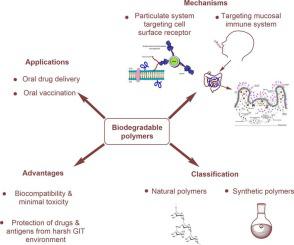当前位置:
X-MOL 学术
›
Eur. Polym. J.
›
论文详情
Our official English website, www.x-mol.net, welcomes your feedback! (Note: you will need to create a separate account there.)
Biodegradable Polymers in Drug Delivery and Oral Vaccination
European Polymer Journal ( IF 6 ) Pub Date : 2021-01-01 , DOI: 10.1016/j.eurpolymj.2020.110155 Pradip Jana , Mousumi Shyam , Sneha Singh , Venkatesan Jayaprakash , Abhimanyu Dev
European Polymer Journal ( IF 6 ) Pub Date : 2021-01-01 , DOI: 10.1016/j.eurpolymj.2020.110155 Pradip Jana , Mousumi Shyam , Sneha Singh , Venkatesan Jayaprakash , Abhimanyu Dev

|
Abstract Over the years biodegradable polymers have emerged as promising polymeric materials in drug delivery and vaccination due to their fascinating properties like biocompatibility, biodegradability, and minimal toxicity. Poor bioavailability is still the major issue for numerous drugs and vaccines delivered through oral route owing to their low solubility, degradation by acidic environment of stomach or by proteolytic enzymes of gastrointestinal tract (GIT). Concepts of oral vaccine delivery targeting mucosal immune system in particulate carriers could give desired immunological response for longer period without any booster doses and thus mitigate the need of repetitive injection and skilled personnel as required in parenteral vaccination. These particulate systems can also protect drugs or proteinaceous antigens from acidic environment or proteolytic enzymes of GIT. In this review the current applications and future scopes of biodegradable polymers like chitosan, alginate, poly (lactic acid-co-glycolic acid), etc., in the development of nontoxic and effective oral carrier systems have been discussed. The improvement in bioavailability of curcumin through encapsulation in polymeric microparticles and immunogenicity of natural antigen as cell envelope proteins (CEPs) upon encapsulation in chitosan microparticles for cholera infection has also been discussed. Similar types of strategies for oral vaccination have also been utilized in the treatment of other infectious diseases. Thus, in nutshell, biodegradable polymers can evolve as an important tool to develop suitable delivery systems in drug delivery and oral vaccination strategies. Further, the review also highlights the loading of drug/vaccine components and subsequently, their release mechanisms from the particulate carrier system.
中文翻译:

药物递送和口服疫苗中的可生物降解聚合物
摘要 多年来,可生物降解聚合物因其生物相容性、生物降解性和最小毒性等迷人特性而成为药物输送和疫苗接种中很有前景的聚合物材料。由于溶解度低、被胃的酸性环境或胃肠道的蛋白水解酶 (GIT) 降解,生物利用度差仍然是许多通过口服途径给药的药物和疫苗的主要问题。以颗粒载体中的粘膜免疫系统为目标的口服疫苗递送概念可以在没有任何加强剂量的情况下提供更长时间的所需免疫反应,从而减少肠胃外疫苗接种所需的重复注射和技术人员的需要。这些微粒系统还可以保护药物或蛋白质抗原免受酸性环境或 GIT 的蛋白水解酶的影响。在这篇综述中,讨论了壳聚糖、藻酸盐、聚(乳酸-乙醇酸共聚物)等生物可降解聚合物在开发无毒有效的口服载体系统方面的当前应用和未来范围。还讨论了通过封装在聚合物微粒中来提高姜黄素的生物利用度,以及在封装在壳聚糖微粒中用于霍乱感染时天然抗原作为细胞包膜蛋白 (CEP) 的免疫原性。类似类型的口服疫苗接种策略也已用于治疗其他传染病。因此,简而言之,可生物降解的聚合物可以发展成为在药物递送和口服疫苗接种策略中开发合适的递送系统的重要工具。此外,该评论还强调了药物/疫苗成分的装载,以及随后它们从微粒载体系统中的释放机制。
更新日期:2021-01-01
中文翻译:

药物递送和口服疫苗中的可生物降解聚合物
摘要 多年来,可生物降解聚合物因其生物相容性、生物降解性和最小毒性等迷人特性而成为药物输送和疫苗接种中很有前景的聚合物材料。由于溶解度低、被胃的酸性环境或胃肠道的蛋白水解酶 (GIT) 降解,生物利用度差仍然是许多通过口服途径给药的药物和疫苗的主要问题。以颗粒载体中的粘膜免疫系统为目标的口服疫苗递送概念可以在没有任何加强剂量的情况下提供更长时间的所需免疫反应,从而减少肠胃外疫苗接种所需的重复注射和技术人员的需要。这些微粒系统还可以保护药物或蛋白质抗原免受酸性环境或 GIT 的蛋白水解酶的影响。在这篇综述中,讨论了壳聚糖、藻酸盐、聚(乳酸-乙醇酸共聚物)等生物可降解聚合物在开发无毒有效的口服载体系统方面的当前应用和未来范围。还讨论了通过封装在聚合物微粒中来提高姜黄素的生物利用度,以及在封装在壳聚糖微粒中用于霍乱感染时天然抗原作为细胞包膜蛋白 (CEP) 的免疫原性。类似类型的口服疫苗接种策略也已用于治疗其他传染病。因此,简而言之,可生物降解的聚合物可以发展成为在药物递送和口服疫苗接种策略中开发合适的递送系统的重要工具。此外,该评论还强调了药物/疫苗成分的装载,以及随后它们从微粒载体系统中的释放机制。


























 京公网安备 11010802027423号
京公网安备 11010802027423号